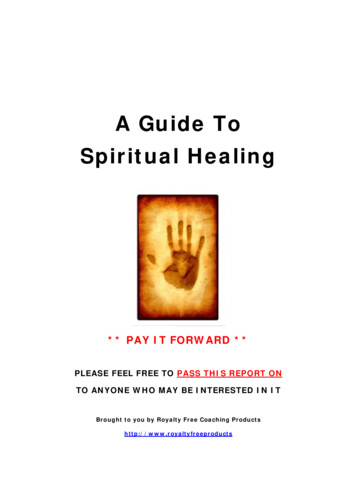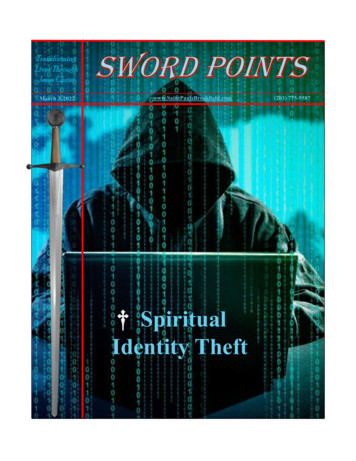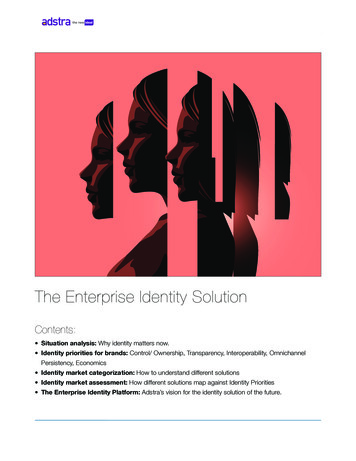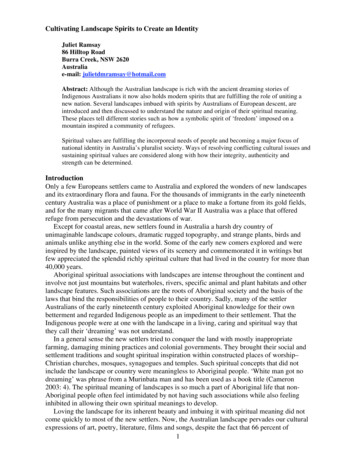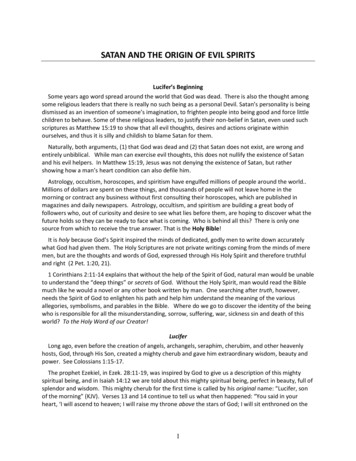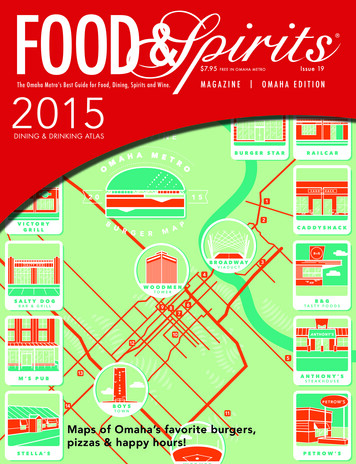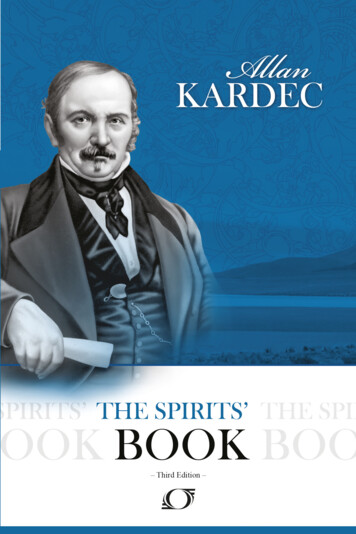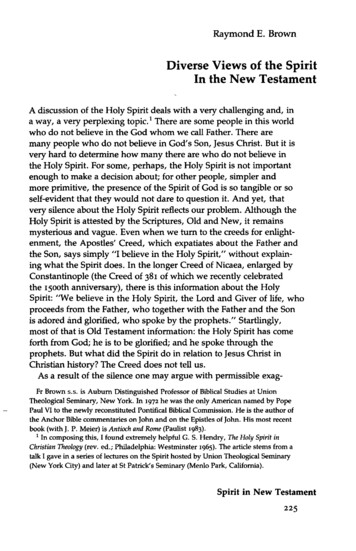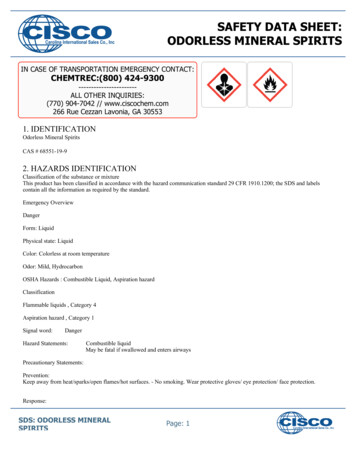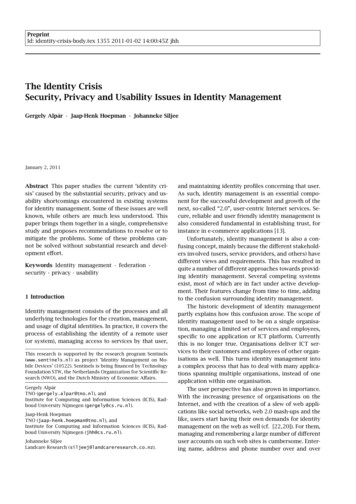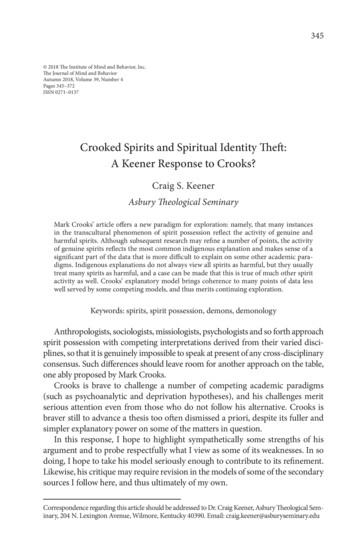
Transcription
345 2018 The Institute of Mind and Behavior, Inc.The Journal of Mind and BehaviorAutumn 2018, Volume 39, Number 4Pages 345–372ISSN 0271–0137Crooked Spirits and Spiritual Identity Theft:A Keener Response to Crooks?Craig S. KeenerAsbury Theological SeminaryMark Crooks’ article offers a new paradigm for exploration: namely, that many instancesin the transcultural phenomenon of spirit possession reflect the activity of genuine andharmful spirits. Although subsequent research may refine a number of points, the activityof genuine spirits reflects the most common indigenous explanation and makes sense of asignificant part of the data that is more difficult to explain on some other academic paradigms. Indigenous explanations do not always view all spirits as harmful, but they usuallytreat many spirits as harmful, and a case can be made that this is true of much other spiritactivity as well. Crooks’ explanatory model brings coherence to many points of data lesswell served by some competing models, and thus merits continuing exploration.Keywords: spirits, spirit possession, demons, demonologyAnthropologists, sociologists, missiologists, psychologists and so forth approachspirit possession with competing interpretations derived from their varied disciplines, so that it is genuinely impossible to speak at present of any cross-disciplinaryconsensus. Such differences should leave room for another approach on the table,one ably proposed by Mark Crooks.Crooks is brave to challenge a number of competing academic paradigms(such as psychoanalytic and deprivation hypotheses), and his challenges meritserious attention even from those who do not follow his alternative. Crooks isbraver still to advance a thesis too often dismissed a priori, despite its fuller andsimpler explanatory power on some of the matters in question.In this response, I hope to highlight sympathetically some strengths of hisargument and to probe respectfully what I view as some of its weaknesses. In sodoing, I hope to take his model seriously enough to contribute to its refinement.Likewise, his critique may require revision in the models of some of the secondarysources I follow here, and thus ultimately of my own.Correspondence regarding this article should be addressed to Dr. Craig Keener, Asbury Theological Seminary, 204 N. Lexington Avenue, Wilmore, Kentucky 40390. Email: craig.keener@asburyseminary.edu
346KEENERAt the outset, I should note that I defer to conventional usage in speaking of“possession,” an imprecise label too often encompassing a diverse range of experiences and degrees (cf. Carter, 2000; Gildea, 1974; Johnson and Keller, 2006).(“Demonization” is closer to the typical New Testament designation, and spans arange of conditions. Arguing for degrees of demonization, see, e.g., Davies, 2008,pp. 25–28; Warner, 1988, pp. 84–86.) Although this may be largely a semanticissue, my usage in this response may differ somewhat from Crooks. By widerdefinitions, both voluntary and involuntary possession states may coexist, sometimes in the same culture (e.g., voluntary for the shaman and “hysterical” for thepatient; Peters, 1981, pp. 147–148; see also Basso, 2006) or even the same person(Berenbaum, Kerns, and Raghavan, 2000, p. 30).Crooks’ Challenge to A Priori AssumptionsEnlightenment prejudice against the “supernatural” may be irrelevant to thequestion of actual spirits if the alleged entities in question are part of nature theway that humans as intelligent actors are. Although the intermediate category of“preternatural” declined in the West after Hume (Daston, 1991, pp. 100–113; cf.Hiebert, 1982, p. 43), it might prove helpful.Semantics aside, how may spirit possession be explored academically? Replicability is an appropriate epistemic demand only in disciplines amenable to it (not,for example, in historiography or journalism). Nevertheless, and while I do notrecommend the exercise, some participant–learner anthropologists have replicated spirit possession experiences with what some participants consider genuinespirits (cf. Goodman, 1988b; Turner, 1993, p. 9; 2006c, p. 203; Wilkie, 1994, pp.137–140; Winkelman and Carr, 2006, pp. 177–178).The Phenomenology of Spirit PossessionAs Crooks notes, studies overwhelmingly confirm the existence of experiencesindigenously interpreted as spirit possession by a vast range of cultures around theworld.1 Strikingly, these observations obtain even though a majority of Westernscholars who study these experiences demur from the indigenous interpretation.(More recent studies tend to be more open to the indigenous interpretations; seeBoddy, 1994, pp. 408, 410–414, 427; Bradnick, 2017; Keller, 2002, pp. 39–40.) Onefinds such observations even in nineteenth-century critics of indigenous interpretations of other paranormal activity, such as David Friedrich Strauss (Fabisiak,2015). Nevertheless, while spirit possession shares some common transcultural1 See Boddy, 1994, p. 409; Bourguignon, 1965; 1973b, pp. 17–19; 1976b, pp. 18–21; Chandra shekar,1989, p. 80; Firth, 1969, p. ix; Morsy, 1991, p. 189; Ward, 1989d, p. 126. For samples, see e.g., Boddy,1994, pp. 428–434; Crapanzaro and Garrison, 1977; Goodman, 1988a, pp. 1–24, 126; Lewis, 1971.
CROOKED SPIRITS AND SPIRITUAL IDENTITY THEFT347traits, many of its features are expressed differently in different cultures (seeBinsbergen, 1981, pp. 90–91; Bourguignon, 1976a, pp. 42–49; Keener, 2011, pp.793–796). In at least some cases, people are socialized into the role of possession,structuring their behavior according to culturally prescribed expectations (see,e.g., some examples in Bourguignon, 1965, p. 48; Lee, 1989, pp. 251–252, 257;Spanos, 1989, pp. 103–108; Wikstrom, 1989, pp. 32–33).Whether due to spirits or not, possession trance, though often culturally patterned, typically displays particular neurological patterns.2 Neurophysiologicalstudies do not demonstrate a particular cause, but they are clear as to some physiological effects (Goodman, 1988a, pp. 1–24, 126).3 The presence of physiologicalelements in anomalous experience, as well as its frequency in a range of unrelatedcultures, clearly shows that exclusively cultural explanations are often inadequate(McClenon and Nooney, 2002, p. 47).Although Western observers have usually explained the behavior differently,Crooks’ observations about spirits’ self-claims are hardly idiosyncratic. Acrossmany unrelated cultures, behavior and voice change drastically during possession,so that “sometimes it has been hard for the anthropologist to persuade himself[or herself] that it is really the same person as before whom he is watching orconfronting” (Firth, 1969, p. x, also noting his own shock when he first witnessedspirit mediumship).4 Possession normally displaces the previous personality(Mbiti, 1970, p. 106; Montilus, 2006, pp. 3–4; cf. Verger, 1969, pp. 50–51, 53).Often the possessed cannot recall the behavior they exhibited during possessiontrance.5 The instances surrounding Jesus, noted by Crooks, do have both ancientand modern parallels (see Keener, 2010b; cf. 2010a; for views about spirits inMediterranean antiquity, see Ferguson, 1984; Keener, 2011, pp. 769–787).Most cases of possession do not produce superhuman strength, but, as Crooksnotes, in some cases it does appear (see e.g., Chandra shekar, 1989, p. 89; Shoko,2 See e.g., Benson, 1982; Benson and Stark, 1996, pp. 163–164; Bourguignon, 1973a, p. 337; Davies,1995, pp. 141–142; Prince, 1968a, pp. 127–129; discussion in McClenon and Nooney, 2002, p. 48.3 For common features in altered states of consciousness through history and in diverse societies, seeMcClenon, 1994, pp. 36–56; 2002, p. 60; McClenon and Nooney, 2002, pp. 47–48; even animals canbe susceptible to hypnotic experiences (McClenon and Nooney, 2002, p. 48).4 Emmons, 1982, p. 193; Evans–Pritchard, 1937, p. 165; Gelfand, 1962, p. 169; Greenfield, 2008, pp.40, 83; Grof, 2010, p. 144; Instone–Brewer, 1996, p. 140; Ising, 2009, pp. 104–105, 168, 169, 171–172,174–175, 178, 183; Mbiti, 1970, pp. 225–226; McClenon, 1994, pp. 134–135, 226; Midelfort, 1992,p. 127; Oesterreich, 1966, pp. 19–22, 97, 208; Scherberger, 2005, p. 62; Shorter, 1985, p. 177; Tippett,1978, p. 162; Turner, 2006a, p. 50; Wilson, 2008, p. 275.5 E.g., Bellamy, 2008, p. 40; Betty, 2005, p. 14; Bourguignon, 1965, pp. 53, 56; Chandra shekar, 1989, p. 87;Field, 1969, pp. 3, 6; Gelfand, 1962, pp. 166, 169; Grof, 2010, p. 145; Horton, 1969, p. 23; Rosny, 1985, pp.185–186; cf. Oesterreich, 1966, p. 13; Singleton, 1978, p. 477 (“posterior amnesia”); but contrast Shorter,1970, p. 113. Some claim to know little about the spirits that possess them, claiming to be “powerless intheir hands” (Shorter, 1980, p. 48). In some studies, hypnotic amnesia involves role playing rather thangenuine neurological amnesia (see Spanos, 1989, pp. 101–102, persuasively; cf. 116–117).
348KEENER2007, p. 125). Such strength can make it difficult or impossible to restrain theperson (e.g., Betty, 2005, pp. 16, 20; Field, 1969, p. 5; Filson, 2006, p. 154; Kaplanand Johnson, 1964, p. 208; Murphy, 1964, p. 58; Oesterreich, 1966, pp. 22–23;cf. Edwards, 1989, p. 210; Ising, 2009, p. 174). It can lead to “violent thrashing”(Beauvoir, 2006, p. 129; Wilson, 2008, p. 275), destructiveness (Eliade, 1958, p.71; Gelfand, 1962, pp. 165, 170; Kaplan and Johnson, 1964, p. 227; Obeyesekere,1977, p. 251; Schmidt, 1964, p. 145) and self-harm (Katz, 1982, pp. 121–122; Lee,1968, pp. 41–42, 47; Mbiti, 1970, p. 106), sometimes including, as in the accountof the demonized man in Mark 5:5, self-laceration (Evans–Pritchard, 1937, p. 162;Fox, 1964, p. 185; Ising, 2009, pp. 174, 326–327; 1 Kings 18:28). In some settingspossession trance yields immunity to pain (Jochim, 1986, p. 154; Mbiti, 1970, pp.225–226) and even to burns (Beauvoir, 2006, p. 130; Bourguignon, 1976a, p. 12;Filson, 2006, p. 76), though not all cases are necessarily authentic or paranormal(Charpak and Broch, 2004, pp. 29–41); see discussion in McClenon, 1994, pp.97–100, 115–126; 2002, pp. 71–76.Benevolent Spirits or Spiritual Identity Theft?Neutral or positive approaches to other cultures help guard observers againstour own prejudices, though personal subjectivity renders elusive complete neutrality. Etic approaches provide crosscultural comparisons more easily than doemic ones, but our academic etic approaches are themselves shaped by particular cultural–philosophic frameworks.6 Goulet and Young (1994, p. 325) questionwhether “any scientific experiment” can resolve whether spirits exist.Nevertheless, academic rigor may allow evaluations from various vantagepoints, provided the vantage points are clearly stated, such as the evaluator’s concern for social harmony, for longevity, for the honor of a particular deity, or thelike. Various spiritual and religious traditions diversely evaluate other traditions,and a truly relativistic approach welcomes all these approaches to the table. Fromthis pluralistic standpoint, Crooks’ model represents one position among many,but as Crooks observes, at many points his model proves especially consistentwith the data that it interprets.Although the ancient monotheistic view of spirit possession was negative,many cultures regard some spirits as neutral or beneficial.7 Some societies seek6 Worldviews provide introductory grids by which to arrange data, but they must be used heuristically, open to transformation; see Silverman, 1972, pp. 204, 228; on presuppositions in social sciences,see also Murphy, 2006, pp. 33–37.)7 See Beattie and Middleton, 1969a, pp. xxi–xxii, xxvii; Brand, 2002, p. 47; Field, 1969, p. 13; Lema,1999, p. 47; Mbiti, 1970, p. 111; opposing traditional Christian approaches, see Grundmann, 2005, p.66; Shorter, 1985, pp. 188–189; Stabell, 2010, pp. 462–463, 470. Krippner, 2002, surveys a variety ofproposed models and data, including the traditional Christian model of shamans’ “demon possession”(pp. 963–964; noting on page 964 that shamans sometimes make these claims about rival shamans),which he rejects, and the various attentional states of different kinds of shamans (p. 967).
CROOKED SPIRITS AND SPIRITUAL IDENTITY THEFT349possession whereas others seek deliverance from it (Bourguignon, 1965, pp.42–43). In some (though not all) cultures, shamans seek possession trance (cf.Eliade, 1964, p. 6; Peters, 1981, pp. 10–11); some who invite possession do so toaccomplish healing (Fuchs, 1964, pp. 135–137; Hien, 2008, p. 307; Licauco, 1988,p. 95; Southall, 1969, pp. 237–238; cf. Obeyesekere, 1970, p. 108). Anthropological literature includes many studies of shamanic healing (see e.g., Goulet andYoung, 1994, pp. 326–327; Scherberger, 2005, pp. 59–64; Turner, 2006a, pp. 56–61;2006b, pp. 103–140; cf. McClenon and Nooney, 2002), although again, extrinsic interpretations vary (see e.g., Young and Goulet, 1994b, pp. 9–10). Althoughmost cultures view witchcraft and curses negatively, not all shamans are considered witches; further, Wicca, a modern Western creation, differs in design fromtraditional witchcraft models (see, e.g., Hayes, 1995, pp. 340–342; Hutton, 2007;Magliocco, 2000).8Demanding associations specifically understood as harmful reduces the casesavailable for study. One may still treat most cases of spirit possession as occult ifone broadens the definition of “occult” to include any sort of possession in spiritual contexts, though in this case many would prefer other terminology. AlthoughI agree with Crooks’ thesis that such spirit possession is negative, I do so especiallybased on my larger theological worldview.9Still, studies may often overplay the social benefits that possession brings to thepossessed while minimizing the problems it causes them (see Hayes, 2006); for atleast some malevolent spirit activity, see e.g., Beattie, 1969, p. 169; Filson, 2006, p. 154;Lewis, 1969, p. 189; Peters, 1981, p. 61; Scherberger, 2005, pp. 57–59; further sourcesin Keener, 2011, pp. 804–808. Contesting the more relativistic approach thoroughlywould require engagement with a vast literature, but Crooks’ thesis on this pointbelongs on the table no less than do other perspectives.Moreover, Crooks reevaluates many previous case studies, frequently highlighting negative social and personal effects of spirit possession that the approachesof Western observers themselves did not take into account. His observations arecrucial; his thesis exposes an obvious blind spot of many competing approaches.(I myself had previously read many of these same studies, often without noticingthe points that he raised; the culturally neutral stance of modern anthropologyis enormously valuable, but also has vulnerabilities, given the interpreter’s ownassumptions.) His thesis about negative associations with possession offers a8 Ontraditional witchcraft and its intentions to harm, see e.g., Azenabor, 2006, pp. 30–31; Binsbergen, 1981, p. 243; Favret–Saada, 1988, pp. 123–127; Hair, 1998, p. 140; Hoare, 2004, pp. 127–128;Mayrargue, 2001, p. 286; McNaughton, 1988, p. 69; Obeyesekere, 1975; Reynolds, 1963, pp. 41–44;Scherberger, 2005, pp. 57–59; Shoko, 2007, p. 46; Shorter, 1985, p. 99; Wyk, 2004, pp. 1202–1204.9 Including, in addition to historic monotheistic considerations, what missiologists call power encounters (Keener, 2011, pp. 843–856). Some differences may be semantic matters of how different scholarsuse the designation “possession”; thus, e.g., Tibbs, 2016, uses language of possession for some NewTestament Christian experience, qualifying and complementing my demurral.
350KEENERprediction, which subsequent studies must follow up with further sifting of observations present in the anthropological, missiological, and historical literature ina way that Crooks’ introductory study could not treat more fully (although someof the literature will miss correlations that the observers were not looking for).10Despite diverse views regarding some spirits, most cultures regard at least someforms of spirit possession as hostile. Modern medical anthropology distinguishesbetween cultures that explain sickness exclusively due to material causes and thosethat often attribute illness to spirits or witchcraft; the latter may constitute a majority of societies.11 (Murdock, 1980, p. 72, found it in more than 97 percent of the 139societies studied.) Not only traditional Christian contexts12 but also a wide varietyof cultures use forms of exorcism, most often in various ritual contexts, to treatpossession illness,13 leading to debates among mental health professionals regarding the ethics of approving exorcisms (whether as genuine cures or placebos).14In some cultures, exorcists themselves experience trance and/or possession statesto expel or manipulate other spirits (Beattie and Middleton, 1969a, p. xxv; Klutz,2004, pp. 196–97; Peters, 1981, pp. 14–15).A significant portion of Crooks’ treatment of occultism comes from Christian sources, often popular ones, that are highly critical of occult experiences.Some do reflect genuine scholarly research (such as Kurt Koch; many essays inthe volume edited by Montgomery; and Nevius); others appear more questionable, such as Hobart Freeman or Penn–Lewis. (I would include Freeman in thosesources that Crooks earlier designated “kooky,” although Crooks is correct that10 He cites voodoo as an example; for possession in Haitian Vodun, see Bourguignon, 1976a, pp.15–27 (esp. the ritual described in pp. 18–21); Douyon, 1968; Kiev, 1968; Perkinson 2001, pp.574–575; Tippett, 1978, pp. 155–156. For voodoo deaths, see e.g., Cannon, 1942. For a differentperspective, see Montilus, 2006.11 Foster, 1976 (noting exceptions on pp. 775–776); esp. Murdock, 1980, pp. 8-27. Brooke, 1991, p.36, notes that some today accept both spiritual and material causes as complementary. For spirit orwitchcraft causes, see e.g., Bourguignon, 1968, p. 17; 1976b, pp. 20–21; Murdock, 1980, pp. 72–76;Neyrey, 1999, pp. 30–31; and the more than forty sources in Keener, 2011, p. 803n99.12 E.g., Geleta, 2002; Greenfield, 2008, pp. 141–142; Klutz, 2004, p. 142; McClenon, 1994, pp. 144–145; 2002, p. 59; Mchami, 2001; Oosthuizen, 1989, pp. 79–80, 89; 1992, pp. 117–148; Sharma, 2001,p. 304. Sometimes it competes with local practice; see e.g., Bergunder, 2001, pp. 103–105; 2008, pp.125–126, 155–158.13 Betty, 2005, pp. 14, 16; Garbett, 1969, p. 105; Goodman, 1988a, p. 125; Gray, 1969, p. 171; Kaplanand Johnson, 1964, p. 211; Lewis, 1969, pp. 199, 201, 213; Mbiti, 1970, p. 106; Nevius, 1894, pp.53–54; Shoko, 2007, p. 97; Tippett, 1967, p. 14; E. Turner 1992a, p. 149; V.W. Turner, 1968, p. 204;for the effectiveness of exorcism in particular kinds of cases, see also Lagerwerf, 1987, pp. 55–56;Shorter, 1980, p. 51.14 E.g., Allison, 2000, pp. 116, 119; Bull, Ellason, and Ross 1998, p. 195; Castro–Blanco, 2005;Hexham, 1977; Heinze, 1988a, p. 14 (as a helpful fiction allowing the experience of multiple personality disorder to be objectified); Krippner, 2002, p. 972; Martínez–Taboas, 2005a, p. 18; 2005b;Shorter, 1985, pp. 184–185; Singleton, 1978, p. 478. Ivey, 2002, regards his psychoanalytic language asitself no less a “mythical” construct than the older demonic terminology (pp. 58–59); Pattison, 1992,p. 217, treats “psychoanalytic psychotherapy” as a secular form of “exorcism.”
CROOKED SPIRITS AND SPIRITUAL IDENTITY THEFT351the observations in these sources may comport with and support more consistent ones.) Certainly much popular exorcism/deliverance today misdiagnoses andmistreats what are not demons (see Burgess, 2008, pp. 228–230; Collins, 2009).Nevertheless, the connection does appear in some professional literature (someof it noted below). As Crooks observes, where genuine paranormal powers appear,the demonological approach provides a more parsimonious explanation thanexclusively neurological approaches.Various Western Academic InterpretationsThe approaches of anthropologists, psychiatrists, psychologists, and indigenous interpreters vary considerably from one another, often leading to criticismof the others (e.g., Ward 1989b, p. 17; 1989c, p. 9; Wendl 1999, p. 120; for the rangeof interpretations, see also Keener 2010b, pp. 227–231). Certainly trance states,including some that are indigenously interpreted as possession, are not limitedto the narrower sort of “possession” emphasized by Crooks, as Crooks recognizes (Lewis, 1971, pp. 39, 44–45, 64; Prince, 1968a, pp. 122–129). Thus even aninduced collapse of an overloaded nervous system may sometimes relieve stressesand aid recovery (Prince, 1968a, pp. 129–130). Some exorcisms probably proveeffective by correcting hysterical disorders, although this explanation proves inadequate for some of the phenomena recorded in the New Testament and othersources (see the analysis by Instone–Brewer, 1996, pp. 134–140).Direct, genuine spirit possession seems unlikely in any cases where suggestion simulates exorcistic deliverance as a placebo; similarly, lack of suggestibilitymay render some versions of “possession” more difficult (cases in Last, 1991, pp.52–53).15 In general, the most hypnotizable 10 percent of people (those most proneto dissociative states) are six times more prone to anomalous experiences thanthe least hypnotizable 10 percent (Pekala and Cardeña, 2000, p. 71). Possession ismore common in cultures that believe in it (Kemp, 1989, p. 75), and explanatorysystems can affect the behavior (Bourguignon, 1968, p. 12). Still, these observationsneed not contest Crooks’ view of demons supervening on some prior conditionsor neurological states.Not all explanations are mutually exclusive, and in some societies conditionsof marginalization increase susceptibility. Even in societies that affirm spiritpossession, stress can provide an obvious precipitating factor or trigger (Wardand Beaubrun, 1980, p. 206). Some anthropologists point out that incidents ofpossession (cf. Bourguignon, 1973a, p. 339; Nevius, 1894, p. 58; Prince, 1968b;Smith, 2001, pp. 452–453; Stoller, 1989; Wetering, 1983) and both witchcraft and15 On the placebo effect, cf. e.g., Beauregard and O’Leary, 2007, pp. 144–150; Droege, 1991, pp. 15–33;Frank, 1961, pp. 65–74; Gaztambide, 2010; Matthews and Clark, 1998, pp. 179–181; Remus, 1997,pp. 110–113.
352KEENERanti-witchcraft movements (Li, 1996) often increase during dramatic changes insociety. Increasing societal stratification (Bourguignon, 1976b, p. 22; Greenbaum,1973a, p. 84; 1973b, p. 54), or at least status ambiguity (Wilson, 1967, p. 377),seems to increase the likelihood of more trance states.Possession thus often appears among those marginalized from other means ofpower in their society (Lewis, 1969, 189–190; Sharp, 1999, p. 4), often especiallywomen (Behrend and Luig, 1999, pp. xvii-xviii; Berger, 1999, pp. 41, 55; Colson,1969, pp. 90–92, 99–100; Kenyon, 1999; Kessler, 1977, pp. 301–302; Lee, 1969, pp.143–144, 150–151, 154; Sousa, 1999; Southall, 1969, p. 244; Stirrat, 1977, pp. 138,151, 154; Walker and Dickerman, 1992). Possession behavior sometimes allowsmarginalized persons access to desired objects or expression of feelings otherwiseinappropriate to express (e.g., Abdalla, 1991, p. 39; Bourguignon, 1965, pp. 50, 53;Chandra shekar, 1989, pp. 88, 91; Lewis, 1992, pp. 315–318; Modarressi, 1968, pp.154–155; Obeyesekere, 1970, pp. 104–105; Wilson 1967, p. 370). Some societiesare also more sympathetic to possession than to acknowledged mental illness(Chandra shekar, 1989, p. 92). In such cases, possession behavior may providesocially sanctioned outlets for feelings.Although trance states may often perform a cathartic function, this approachdoes not account for societies where the healer rather than the patient “becomesdissociated” (Prince, 1977, p. xiii). Trance states are more common among theuneducated (Field, 1969, p. 4; Oesterreich, 1966, pp. 99, 121, 165, 203, 205), buturbanization and western education do not always displace possession and exorcism (cf. Behrend and Luig, 1999, pp. xiii–xiv; Emmons, 1982, p. 191; Jacobs,1976, pp. 186–187; Makris and Al-Safi, 1991, p. 118; Shorter, 1985, p. 179).There are, however, limitations to these observations, since they predictaverages rather than individual case outcomes. Some challenge the ideologicalunderpinnings of deprivation hypotheses regarding possession (Binsbergen,1981, pp. 86–87; cf. 24–25, 77–86), viewing them as reductionist (cf. Hunt, 2010,pp. 183–184; McClenon, 2002, pp. 59–60; Miller and Yamamori, 2007, p. 156).Treating the spiritual experience of “underprivileged people” as “hallucinations”demeans them (Turner, 1992a, p. 3).The data do not all reduce to a single consistent model, and correlation maysometimes reflect common factors rather than causation; but they might alsoreveal some conditions most conducive to possession states. Susceptibility doesnot necessarily explain etiology, and cases of socially generated possession neednot rule out genuine demonic activity that originally informed cultural models.Various Indigenous InterpretationsCultures themselves vary widely in their frameworks for interpreting possession experiences (see e.g., Bourguignon, 1968, pp. 4–12; Lewis, 1971, p. 44;Pattison, 1992, pp. 205–206; Peters, 1981, pp. 11–16, 46–47, 50). Still, various
CROOKED SPIRITS AND SPIRITUAL IDENTITY THEFT353cultures' similar experiences generate some similar beliefs even in a number ofvery different societies (McClenon and Nooney, 2002, p. 47).While Crooks’ negative view of spirit possession is not dominant outsidemonotheistic traditions, his view that spirits are real is easily the most commonview among cultures globally, especially among cultures most directly familiarwith such experiences. Even in the United States, a majority of people believe inthe reality of spirits. This belief declines somewhat, though only somewhat, withincome and education (Baker, 2008, pp. 211–213), the latter itself often reflectinga form of enculturation.One of the most widespread interpretations is possession or affliction by ancestor spirits or other deceased relatives, though in most cultures ancestors do notpossess (Hammond–Tooke, 1989, pp. 55–56).16 Some view these spirits favorably(see Garbett, 1969, p. 105; Last, 1991, p. 51; V.W. Turner, 1968, p. 14), but manydeem them dangerous.17 Religious or cultic contexts for possession behavior arecommon (Gray, 1969, p. 171; Tippett, 1978, pp. 148–151), for example in HaitianVodun (Bourguignon, 1976a, pp. 15–27; Douyon, 1968; Kiev, 1968; Perkinson,2001, pp. 574–575), Taoist rituals (Nevius, 1894, p. 47), Brazilian spiritism (Tippett,1978, pp. 157–158; Pressel, 1973; 1977, pp. 333–335), in the zar cult (Modarressi,1968) and in Sinhalese and Indo–Tibetan Buddhism (Ames, 1964, pp. 33, 40–41;Wayman, 1968). Cultic contexts often produce social pressure on particular personsto enter possession trance (Firth, 1969, p. xiii; Horton, 1969, pp. 24, 25, 35; Verger,1969, p. 52).Western Scholars and Actual SpiritsCrooks is not alone among Western scholars in arguing that actual spiritsexist (e.g., Betty, 2005, and sources cited there; Isaacs, 1987; Johnson, 1982; Sall,1976). While usually rejecting the reality of spirits, postmodernists are moreopen than were modernists (Goulet and Young, 1994, pp. 323–325; Hoffmanand Kurzenberger, 2008, p. 84), and anthropologists have grown increasinglyopen to indigenous understandings (see Keller. 2002, pp. 39–40; Wilson, 1994,pp. 198–206). An increasing number of Western scholars have also begunrecounting their own unexpected experiences with spirits (e.g., Kimball, 1972,16 SeeChandra shekar, 1989, p. 81; cf. Barrington–Ward, 1978, p. 456; Beattie and Middleton, 1969a,p. xxvii; Bourguignon, 1976a, pp. 24–27; Eliade, 1964, pp. 365–366; Emmons, 1982, pp. 171–172,175–176; Field, 1969, p. 9; Hien, 2008, pp. 312, 316; Keller, 2002, pp. 131–132, 155; Jules–Rosette, 1981,pp. 133, 142; Lee, 1969, pp. 131–132; Oesterreich, 1966, pp. 26–27, 186, 209; Zempleni, 1977, p. 92.17 Beattie, 1969, p. 162; Colson, 1969, p. 71; Garbett, 1969, p. 123; Obeyesekere, 1977, p. 239; Reynolds,1963, p. 62; Tenibemas, 1996, p. 23; Turner, 1992a, p. 182; W. Ma, 2002, p. 207; cf. Byaruhanga–Akiikiand Kealotswe, 1995, pp. 111–112; Horton, 1969, p. 15; Shoko, 2007, p. 45 (witches exploit spirits ofthe dead to steal for them); Southall, 1969, pp. 233 (spirits of deceased soldiers), 246–249, 255 (spiritsof earlier chiefs); Welbourn, 1969, pp. 291–292 (on dangerous ghosts).
354KEENERpp. 188–192; Steyne, 1990, pp. 14–19; Stoller, 1984, p. 110; Young, 1994, p. 174;earlier, Nevius, 1894, pp. ix, 9–13). Local scholars who have not embraced thedominant Western worldview speak even more freely (e.g., Mbiti, 1970, pp.253–256; Mensah, 2008, p. 176).Some scholars have experienced possession or the “paranormal” but explaintheir own experience as possibly merely subjective (McClenon, 1994, pp. 236–237;Peters, 1981, pp. 47, 50). Others go further and attribute their own experiences toactual spirits; most notable is Edith Turner, lecturer in anthropology at the University of Virginia and editor of Anthropology and Humanism. Now embracing aproshamanist perspective, she critiques her previous role as a skeptical, nonparticipant anthropological observer as cultural imperialism (Turner, 1992c, p. 28; 1997;cf. Swarz, 1994, p. 209), which she compares to the ethnocentrism of Christianmissionaries (Turner, 1992c, p. 30). Turner’s own experiential research began withher “experience of seeing a spirit” during a ritual in Zambia (Turner, 1996, pp.xxii–xxiii; cf. Turner, 1992a, pp. 149, 159; 1992b, p. 2; 1993, p. 9; 1994; 2005, p. 403;2006a, p. 43; 2006b, pp. 1–23). She dismisses as ethnocentric the assumption thatanthropological training qualifies one to “understand aspects of a culture betterthan field subjects” with their generations of cumulative experience (Turner, 1992a,p. 4; cf. 1992c, p. 30). Turner subsequently participated in her traditional Eskimohosts’ experiences with what she deems real spirits (Turner, 1992c,
CROOKED SPIRITS AND SPIRITUAL IDENTITY THEFT 347 traits, many of its features are expressed differently in different cultures (see Binsbergen, 1981, pp. 90-91; Bourguignon, 1976a, pp. 42-49; Keener, 2011, pp. 793-796). In at least some cases, people are socialized into the role of possession,
